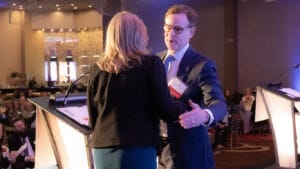Each year when April 22 rolls around, thousands of companies trumpet their sustainability initiatives.
Rising in popularity with corporate tenants and their landlords (and even municipalities like New York City and San Francisco), green leases are one way to both validate a company’s dedication to sustainability and achieve green victories throughout the year via improved environmental performance of a leased office space and an assurance that the company occupying this space — and the landlord that owns the building — are operating in a sustainable manner from the inside out.
“Green leases combine the productivity, comfort and sustainability features that tenants are looking for in office space while supporting landlord priorities of improving the triple bottom line and occupancy rates,” said Michael Jordan, Executive Vice President of Sustainability Strategy for Jones Lang LaSalle (JLL), a global leader in green lease administration.
“In addition to achieving both tenant and landlord objectives, green leases have social, economic and environmental implications for companies operating in today’s global economy. Green leases truly are the future of commercial real estate.”
Jordan and the JLL Energy and Sustainability Services team recommend that tenants and landlords collaborate to develop a green lease that benefits each party, typically including the following 10 benefits:
>> Reduce Utility Consumption and Save Money
>> Improve Working Relationships Between Tenants and Landlords
>> Support Corporate Sustainability Initiatives
>> Enhance Corporate Image/Brand
>> Demonstrate Vision and Thought Leadership
>> Improve Civic Relations
>> Contribute to LEED and Other Green Certifications
>> Improve Employee Productivity, Recruitment and Retention
>> Generate Additional Savings Through Waste Stream Diversions
>> Do the Right Thing for the Environment and its People
To make a lease “green,” the terms must be structured to drive sustainable cost savings without negatively impacting building performance or comfort. As with every lease, the green criteria should undergo careful evaluation to maximize effectiveness, sustainable success and cost savings.
“When weighing the costs and benefits of a green lease, consider completing an in-depth green lease site assessment and integrating RFP language that incorporates benchmarked green criteria applicable to both new leaseholds and renewing/renegotiating existing ones,” said Meaghan Farrell, Vice President of Strategic Consulting for JLL.
“Working with an advisor that understands both commercial leasing and green leases is critical to achieving both your real estate goals and your sustainability target.”
Jones Lang LaSalle employs 1,500 energy and sustainability accredited professionals in more than 30 countries around the world with skills in facility and property management, energy assessments, retro-commissioning, retrofits, project management, LEED and other certifications, renewable energy, sustainability consulting, renewable power solutions, workplace strategy, green lease programs, employee engagement and sustainability program design.
JLL is an ENERGY STAR Sustained Excellence Partner and a lead sponsor of the Carbon Disclosure Project (CDP) Cities program.



